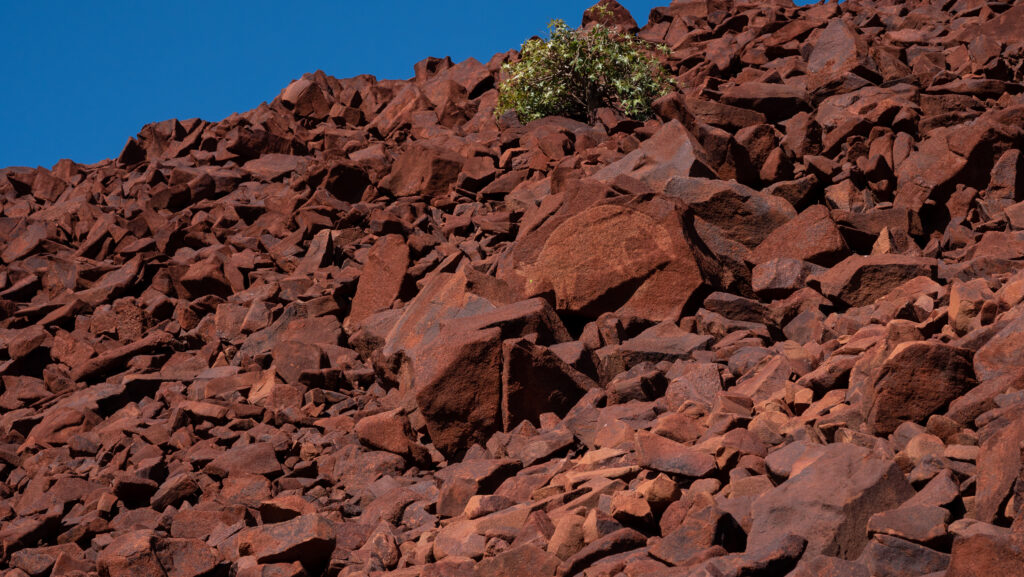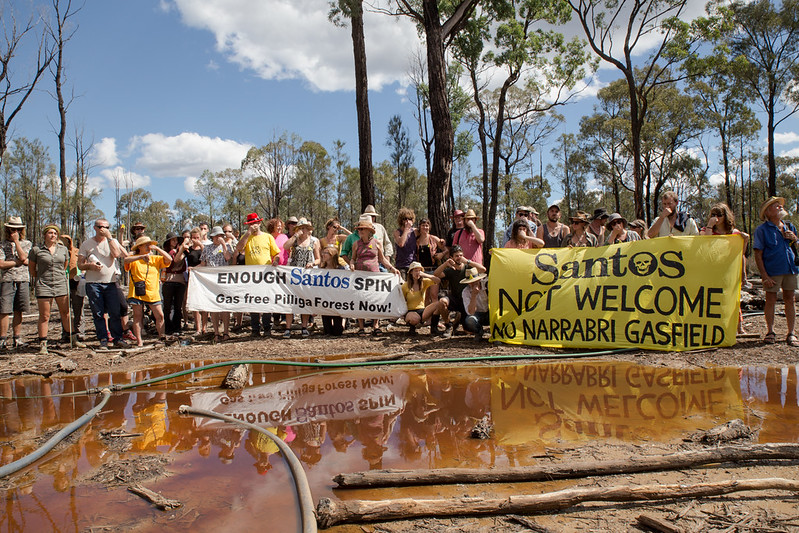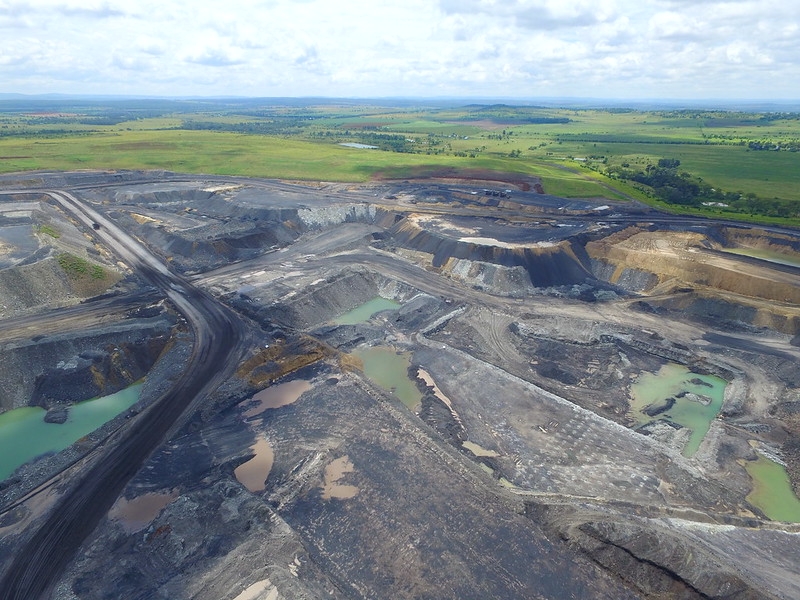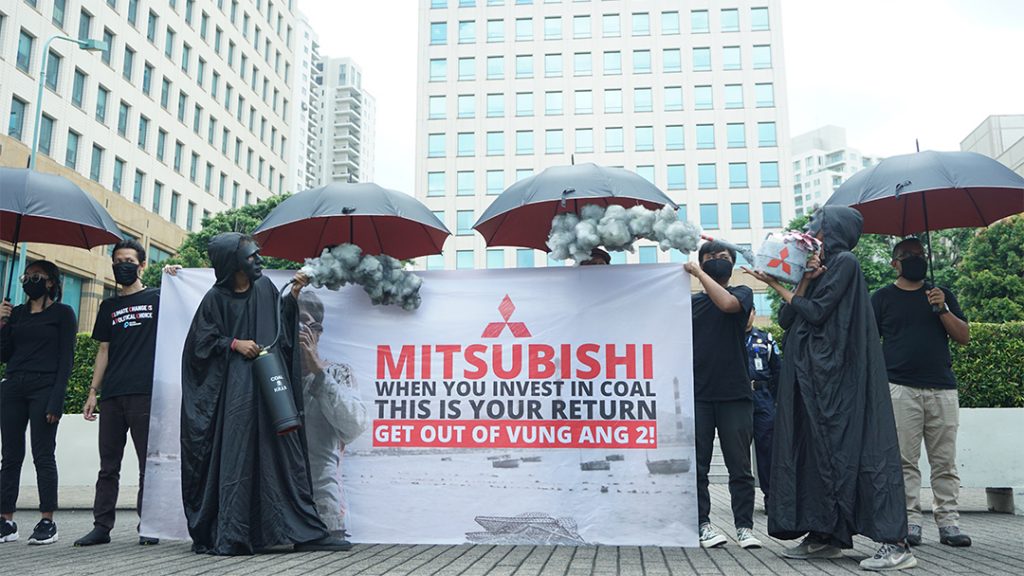21 July 2022
In response to member concerns over their super fund’s investments in climate wrecking companies, funds often point members to their ‘sustainable’ investment options. However, new analysis from Market Forces reveals some of these options are failing to live up to their labels, as they invest in companies expanding the fossil fuel industry.
We’ve analysed the holdings of the ‘sustainable’ or ‘socially responsible’ investment options of Australia’s biggest super funds, and the results are alarming. Several of these so-called ‘sustainable’ options are invested in companies with massive fossil fuel expansion plans.
Mercer, for example, claims its ‘Sustainable Plus’ options exclude thermal coal companies, yet the ‘Sustainable Plus Growth’ option is invested in Whitehaven Coal and New Hope Corporation, among several other companies expanding the scale of the climate wrecking thermal coal industry. Similarly, CareSuper’s Sustainable Balanced option invests in the likes of Woodside, BP, Chevron, Exxon, and Shell.
Australia’s corporate regulator ASIC has recently warned that offering or promoting sustainability-related financial products that are not ‘true to label’ or using ‘vague terminology’ could breach misleading and deceptive conduct and/or disclosure rules. However, we have identified that eight so-called ‘sustainable’ options out of the eleven captured in this analysis had some investments in companies expanding fossil fuels.
Market Forces has asked ASIC to investigate the potential greenwashing concerns identified by this analysis.
Super funds need to make sustainable investment their core business by divesting from companies expanding fossil fuels across all investment options.
Take action! Tell your fund to clean up its act and divest from companies expanding fossil fuels.
Take action
Tell your super fund to stop the greenwashing and divest from companies expanding fossil fuels.
The investment exposure of Australia’s biggest super funds’ ‘sustainable’ investment options to the Climate Wreckers Index
The Climate Wreckers Index is made up of the 180 publicly-listed companies from all over the world with the biggest plans to expand the scale of the fossil fuel industry. The “Exposure to Climate Wreckers Index” column in the table below shows the extent to which each super fund investment option’s listed equity investments is in these climate wrecking companies.
| wdt_ID | Fund | Investment option profiled | Examples of climate wreckers this option invests in | Exposure to Climate Wreckers Index (% of listed equities) | Fossil fuel exclusion policy |
|---|---|---|---|---|---|
| 1 | Australian Retirement Trust | Socially Conscious Balanced | N/A | 0.00 | This option excludes investments in companies that generate more than 5% of their revenue from fossil fuel exploration, mining or energy generation. |
| 2 | AustralianSuper | Socially Aware | TEPCO, Chubu, KEPCO, CLP | 0.13 | This option excludes investment in companies that "...directly own fossil fuel or uranium reserves," which AustralianSuper defines as "...thermal coal, oil, gas or uranium." However, it does not exclude some sub-sectors of the coal, oil and gas industries, most notably coal and gas power generation. |
| 3 | Aware Super | Diversified Socially Responsible Investment | N/A | 0.00 | Aware Super applies the following ‘climate change screens‘ to this option, meaning it excludes investment in: coal, coal-fired power generation, oil and gas (conventional / unconventional), fossil fuel transportation, fossil fuel supply chain and services, fossil fuel reserves. |
| 4 | CareSuper | Sustainable Balanced | Woodside, BP, Chevron, Exxon, Shell, TEPCO, Chubu, Equinor | 6.30 | This option excludes investment in "...companies that generate more than 10% of their revenue" from thermal coal production and thermal coal for power production. |
| 5 | HESTA | Sustainable Growth | Siemens AG | 1.03 | This investment option excludes any company that "...derives any revenue from the mining of thermal coal and the extraction, production, and refining of conventional and unconventional oil and gas; or derives 15% or more revenue from the generation of electricity from fossil fuels or transportation, distribution or retailing of conventional and unconventional oil and gas; or derives 15% or more revenue from equipment and services for the exploration and production of conventional and unconventional oil and gas; or derives 50% or more revenue from indirect services to the fossil fuel sector (for example, the provision of specific materials, contracted services and transportation)." |
| 6 | Hostplus | Socially Responsible Investment (SRI) Balanced | General Electric | 0.12 | This option excludes “companies that own reserves, explore, mine, extract, produce, refine or generate energy from fossil fuels as well as those companies that receive revenue from servicing these sectors through equipment services, pipeline transport or distribution. A zero-materiality threshold is applied, but dedicated renewable energy generators with backup fossil fuel sources (<5%) may remain investible." |
| 7 | Mercer | Sustainable Plus Growth | Woodside, Santos, Whitehaven Coal, New Hope Corporation, BP, Chevron, ExxonMobil, Shell, TEPCO, Chubu, Equinor | 7.45 | This option claims to exclude "...companies involved in... carbon intensive fossil fuels like thermal coal." Mercer also states: "The list of companies excluded varies for each [Sustainable Plus] investment option." The fund doesn't appear to disclose any further information about the specific exclusions applied across its Sustainable Plus investment options, but this option does have some investments in a number of coal companies. |
| 8 | Rest | Sustainable Growth | Mitsubishi Heavy Industries, Siemens AG | 0.22 | This option excludes any company which: "...owns fossil fuel (thermal coal, metallurgical coal, oil and gas) reserves [and] derives revenue from oil and gas exploration, production and related activities (pipeline transportation, refineries, and oil and gas equipment and services, [and] power generation from thermal coal, oil and gas [and] the leasing, mining and processing of coal and coke.” |
| 9 | Super SA | Triple S Socially Responsible | Sumitomo Chemical Co | 0.03 | Super SA does not appear to have publicly disclosed its fossil fuel exclusion policy for this option. However, the Funds SA website states: "The option invests in line with socially responsible investment criteria established by Funds SA, which includes a focus on renewable energy and social infrastructure, restrictions on investments in areas of high negative social impact and a ‘best-in-class’ approach to target the best companies in each economic sector according to external ESG ratings." |
| 10 | UniSuper | Sustainable Balanced | N/A | 0.00 | UniSuper states: "We exclude companies classified as: coal, oil and gas producers, coal miners, energy, oil and gas explorers, diversified metals and miners. We exclude companies with greater than 10% revenue from fossil fuel exploration and production. We consider utilities for investment if they’re largely involved in renewable energy—provided they derive less than 30% of energy generation from natural gas only (excluding any coal generation). This allows for energy security/back-up generation capabilities." |
| 11 | Vision Super | Sustainable Balanced | BP, Exxon, Shell, Santos, TEPCO, Woodside | 4.71 | Vision Super excludes companies that generate more than 25% of revenue from the mining of thermal coal. According to Vision Super’s 2017 Corporate Responsibility Report, the Sustainable Option “specifically seeks to invest in companies that are considered sustainability leaders and avoid companies with material exposure to controversial weapons, fossil fuel exploration and production” and “100% of the equity allocation managed to a low-carbon benchmark.” Vision Super also released an updated ESG policy in June 2021, restated in December 2021, which notes partial divestment from oil and gas companies. The policy states “Vision Super will not invest in companies that derive material revenue from oil and/or gas extraction where such investments are directly held,” meaning that the policy applies only to the fund’s active holdings (as opposed to its passive holdings). |
Holdings information as at 31 December 2021. See bottom of page for methodology and sources.
*In order to compare options with different allocations to publicly-traded company shares (listed equities), we calculated each fund’s investment exposure to the Climate Wreckers Index as a proportion of its total allocation to listed equities, minus any investments in pooled or managed investment fund products, such as Exchange Traded Funds (ETFs). This allows us to properly compare options’ direct investments in Climate Wreckers Index company shares. You can read the full methodology below.
Climate wrecking company case studies
Woodside Petroleum
Woodside is pursuing massive new oil and gas projects consistent with the failure of the Paris Agreement, including the monstrous Scarborough gas field off the coast of Western Australia (WA), and the associated Pluto Train 2 liquified natural gas (LNG) processing plant. The proposed Scarborough-Pluto project could result in the emissions equivalent of 15 coal-fired power stations running for 30 years, threaten to accelerate degradation of the Murujuga rock art (proposed for World Heritage listing) due to industrial emissions, and would also cause significant impacts to the local marine environment. Independent analysis has concluded the Scarborough-Pluto combined project “…represents a bet against the world implementing the Paris Agreement”.

Woodside recently doubled its oil and gas production capacity by taking over BHP’s petroleum business. Despite the urgent need for fossil fuel production to begin declining in line with global climate goals, Woodside plans to significantly increase the combined total of Woodside and BHP’s oil and gas production over the next five years. Beyond clearly contravening the IEA’s key conclusion that there is no room for new oil and gas production projects in the pathway to net zero emissions by 2050, a number of independent analyses of new oil and gas production projects being pursued by Woodside reveals how significantly out of line they are with global climate goals. Carbon tracker, for example, has found that Woodside’s proposed Pluto Train 2 facility is not even financially competitive in a catastrophic 2.7°C global warming scenario, let alone in a world where we achieve the 1.5°C goal of the Paris Agreement.
Santos
Santos is pursuing massive new oil and gas projects consistent with the failure of the Paris Agreement, including the dangerous and destructive Narrabri gas project in the Pilliga Forest, New South Wales (NSW). Santos has recently undergone a merger with Oil Search to make the combined business one of the 20 largest companies on the Australian Securities Exchange (ASX). This new fossil fuel giant has one main aim: produce more oil and gas. In fact, Santos is pursuing major new projects that would increase its production by at least 17% from 2020 to 2030, despite the urgent need for fossil fuel production to begin declining in line with global climate goals.
Santos plans to drill 850 gas wells throughout the Pilliga Forest and surrounding farmland near Narrabri, NSW. The company is still desperately pursuing this toxic project, despite years of opposition from local Gomeroi Traditional Owners and farmers, as well as former Chief Scientist Penny Sackett, who has confirmed the project is inconsistent with the Paris Agreement and net zero by 2050. Santos has even gone so far as to submit an application to the National Native Title Tribunal, in an attempt to extinguish Gomeroi Traditional Owner native title rights over the Pilliga. The Narrabri project makes it clear that Santos will stop at nothing in the pursuit of climate wrecking gas, including trashing Indigenous cultural heritage.

Santos is also pushing ahead with its Barossa gas project, a massive new proposed gas field 300km North of Darwin, Northern Territory (NT). If the project goes ahead, Santos will transport gas from the Barossa field to an existing LNG processing facility in Darwin. The extremely high carbon dioxide (CO2) content of Barossa gas is three times greater than the Darwin LNG plant can handle, leading energy experts to state that the Barossa to Darwin LNG project looks like it’s shaping up to become “…a CO2 emissions factory with an LNG by-product.” Traditional Owners have taken their fight against Barossa to the Federal Court.
Whitehaven Coal
Whitehaven Coal is the biggest undiversified coal mining company on the Australian share market. Whitehaven’s plans to massively expand the coal industry are completely at odds with the Paris Agreement goal of limiting global warming to 1.5ºC. To justify its business plans, Whitehaven refers to coal demand scenarios consistent with a catastrophic 3ºC of global warming.
Whitehaven is planning to spend around $2 billion on three new coal mines and expansions: Vickery, Narrabri Stage 3 and Winchester South. These mines have marketable coal reserves of almost 500 million tonnes. When emissions from digging up and burning the coal are added, over their lifetimes these three mines would unleash almost 1.1 billion tonnes of carbon emissions, the equivalent of almost twice Australia’s annual emissions.
New Hope Corporation
New Hope is an Australian-based undiversified coal mining company deriving more than 95% of revenue from the sale of thermal coal. Despite there being no room for new or expanded coal mines if we’re to achieve the climate goals of the Paris Agreement or net zero emissions by 2050, New Hope is pursuing a major expansion of its New Acland coal mine on some of Queensland’s best farming land.
New Hope plans to spend around $900 million on its New Acland Stage 3 coal expansion, one of the most contested coal mining projects in Australian history. New Hope has determined there’s a further 200 million tonnes of coal reserves at New Acland, and Stage 3 would increase the mine’s production capacity to 7.5 million tonnes per year and extend its production life by 12 years.

Aside from the physical destruction of this prime farming land, there is deep community concern about the impact of the mine on local groundwater aquifers. According to the Oakey Coal Action Alliance, around 20,000 hectares of cropping land surrounding the mine is at risk of permanent groundwater impacts. Despite several rounds of water modelling revisions, expert scientists remained unconvinced by New Hope’s final water management plans.
TEPCO & Chubu
TEPCO, Chubu and their joint venture JERA are betting against the climate goals of the Paris Agreement and undermining their own net zero emissions commitments by expanding the liquefied natural gas (LNG) and coal power sectors.
JERA is responsible for a whopping 169 MtCO2-e annually, or 15% of Japan’s annual emissions (2020). The company is currently constructing three additional coal-fired power plants – two in Japan and one in Indonesia.
JERA is also pursuing significant involvement in the LNG sector, including gas fields, LNG terminals and LNG to power projects in countries such as Australia, Bangladesh, and Vietnam. This includes a stake in the new Barossa gas field, a controversial project in northern Australia opposed by First Nations communities, which has been labelled ‘both a major financial risk and a serious climate risk’. In addition, a recent court proceeding filed in Korea is raising doubts on the project’s ability to secure finance.
Mitsubishi Corp
Mitsubishi Corp is expanding fossil fuels in three separate areas: gas power plants, coal production, and oil and gas production.
Mitsubishi is expanding its gas business by building gas fields, LNG terminals and LNG to power projects, contrary to the International Energy Agency (IEA)’s ‘Net Zero by 2050’ scenario (NZ2050), which makes clear that achieving net-zero emissions by 2050 means no new fossil fuel supply and an extremely limited and narrowing role for fossil fuels in electricity generation.
Meanwhile, Mitsubishi’s coal mining subsidiary is expanding its metallurgical coal mining operations in Australia.
Mitsubishi Heavy Industries is a Mitsubishi Corp subsidiary that produces coal and gas power plant equipment, among other things.

General Electric
General Electric (GE) has historically been heavily involved in coal power generation, both in the United States and also as a developer of coal power plants internationally. While the company announced it is exiting new coal power builds, it is planning major expansions in the LNG and gas power sectors.
Market Forces’ research has found GE is involved in new LNG to power plants in Vietnam and Bangladesh with combined capacity of 24.6 GW.
Sumitomo Corporation
Sumitomo Corporation has been linked to 6,200MW of proposed LNG to power projects in Bangladesh, Thailand and Vietnam, the sites of the three largest gas power project expansions (outside China). While the company has exited coal power and the polluting Matarbari 2 coal power project after years of campaigning from communities in Bangladesh, Japan and around the world, it is continuing to build the controversial Matarbari 1 coal power project. The Matarbari 1 project has already resulted in damage to local waterways while people have been displaced and lost their livelihoods as a result of construction.
Sumitomo Chemical Co is a Sumitomo Corp subsidiary that is “expanding its petrochemical business in various regions across the globe.”
Siemens
Siemens is linked to 7,500MW of proposed LNG to power projects in Bangladesh, Thailand and Vietnam, the sites of the three largest gas power project expansions (outside China). The company is also supporting the highly-controversial Adani Carmichael project, providing the signalling for the Carmichael rail line through its subsidiary, Siemens Mobility.
More information
What is the Climate Wreckers Index?
The Climate Wreckers Index is made up of the 180 publicly-listed companies from all over the world with the biggest plans to expand the scale of the fossil fuel industry. Specifically, the list includes:
- The top 60 oil and gas producers by expansion plans
- The top 60 coal miners by expansion plans and coal reserves
- The top 30 companies by new gas power plant development plans
- The top 30 companies by new coal power plant development plans
See the methodology for determining companies on the Climate Wreckers Index here.
Methodology
Scope
The scope of our analysis covers the ‘sustainable,’ ‘socially responsible’, or ‘socially aware’ investment options of Australia’s largest 30 super funds by assets under management, according to APRA’s June 2021 fund-level superannuation statistics (Table 1 and Table 2). Further to these APRA-regulated funds, our analysis includes state-regulated funds that would otherwise fall within the largest 30 APRA-regulated funds by assets under management.
Where mergers between super funds have occurred since June 2021, the single merged entity is listed on the table and occupies only one position on the table, unless the merged funds were found to have clearly separate default options with different investments.
This analysis excludes the investment options of funds that have not disclosed the option’s full list of listed equity holdings, such as those that outsource the investment management of listed equities by investing in a passive indexed product, for example. These funds and options are: ESSSuper Ethically Minded, LGIAsuper SR Balanced, and Spirit Super Sustainable.
Process: Exposure to Climate Wreckers Index
Portfolio holdings disclosures were collected for the funds listed in the table above. These holdings were filtered for listed equities, and all investments whose names matched companies in the Climate Wreckers Index were extracted. The total investment exposure to Climate Wreckers Index companies was calculated as a percentage of total listed equities in the option, minus any allocation to pooled or managed investment fund products within the total listed equities allocation.
Details
- Portfolio holdings disclosures are as at 31 December 2021.
- ‘Total listed equities allocation’ does not include derivatives.
Sources
Portfolio holdings disclosures for all funds are as at 31 December 2021, and were sourced from each fund’s website:
Disclaimer
The information provided by Market Forces does not constitute financial advice. The information is presented in order to inform people motivated by environmental concerns and take actions based on those concerns. Market Forces is organising data for environmental ends.
The information and actions provided by Market Forces do not account for any individual’s personal objectives, financial situation or needs. It should not be used, relied upon, or treated as a substitute for specific professional advice.
Market Forces recommends all users obtain their own independent professional advice before making any decision relating to their particular requirements or circumstances. Switching super funds may have unintended financial consequences.
For more information about Market Forces, please visit the about page of the site.
